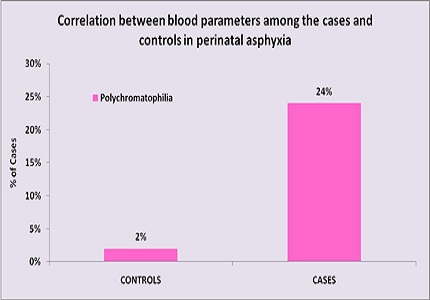Study of hematological parameters among newborns with perinatal asphyxia
Abstract
The aim of this original research article was to identify the blood parameters as predictors of perinatal asphyxia and its correlation with severity of asphyxia.
Setting: Postnatal Wards and Sick newborn unit of Pediatric Department, Kamla Raja, Gwalior.
Design: A prospective case control study.
Participants: 100 cases and 100 controls enrolled based on the selection criteria, on day 1 of life.
Methods: On day 1of delivery newborns were enrolled, who fulfilled the inclusion criteria. Complete history, physical examination and neurological signs were recorded on a predesigned proforma. Hypoxic ischemic encephalopathy (HIE) Staging done. Cord blood samples were collected on day 1 and results analyzed.
Results: The present study included 100 cases and 100 controls. Out of the total 100 cases, 23% (23) were HIE stage-I, 46% (46) were stage-II and 31% (31) were of stage –III Significant difference is seen in mean values of nucleated RBCs among the cases and controls (p value <0.001). It was 10.85 ± 6.39 and 5.91 ± 3.60 among cases and controls respectively. Leucocyte count was found 17.06 ± 7 among cases while among controls mean was 14.14 ± 4.15, which was significant. Similarly, significant difference was found in mean Hb among cases and control group. Polychromatophilia was found significant (p value <0.001) when compared between cases and controls and among cases themselves. The value of Positive predictive Value and Negative Predictive Value are maximum for n-RBCs. Accuracy for determining the mortality is also maximum. It is seen that area AUC for n-RBCs is maximum i.e. 0.795 which makes it the best blood parameter which correlates with mortality.
Conclusions: Blood parameters are altered in perinatal asphyxia and can be used to predict the severity and outcome.
Downloads
References
2. State of World’s children, UNICEFF Report: Maternal and Newborn health; 2009.
3. de Haan M, Wyatt JS, Roth S, Vargha-Khadem F, Gadian D, Mishkin M. Brain and cognitive-behavioural development after asphyxia at term birth. Dev Sci. 2006 Jul; 9 (4):350-8. [PubMed]
4. Jonathan M Spector & Subhash Daga. Preventing those so-called stillbirths. Bulletin of the World Health Organization 2008 April, 86 (4).
5. Curtin WM, Shehata BM, Khuder SA, et al. The feasibility of using histologic placental sections to predict new born nucleated red blood cell counts. Obstretic Gyaenecoly, 2002 Aug; 100(2):305-10.
6. Rolfo A, Maconi M, Cardaropoli S, Biolcati M, Danise P, Todros T. Nucleated red blood cells in termfetuses: reference values using an automated ana-lyzer.Neonatology.2007;92(3):205-8.Epub2007Apr 30
7. Azra Haider B, Bhutta ZA. Birth asphyxia in developing countries: currentstatus and public health implications. Curr Probl Pediatr Adolesc Health Care. 2006 May-Jun; 36(5):178-88. [PubMed]
8. Ruchi Rai, Gaurav Tripathi And Dk Singh. Nucleated RBC Count as Predictor of Neurological Outcome in Perinatal Asphyxia’ Indian journal of pediatrics, 2014 March, vol 51,231.
9. Hermansen MC. Nucleated red blood cells in the fetus and newborn. Arch Dis Child Fetal Neonatal Ed. 2001 May; 84 (3):F211-5. [PubMed]
10. Phelan JP, Kirkendall C, Korst LM, Martin GI. Nucleated red blood cell and platelet counts in asphyxiated neonates sufficient to result in permanentne urologic impairment. J Matern Fetal Neonatal Med. 2007 May; 20(5):377-80. [PubMed]
11. Korst LM, Phelan JP, Ahn MO, Martin GI. Nucleated red blood cells: an update on the marker for fetal asphyxia. Am J Obstet Gynecol. 1996 Oct;175 (4 Pt 1): 843-6.
12. GTomar, Sikarwar S, Gupta S. The Correlation Of Clinical Perinatal Asphyxia With Counts Of Nrbc /100 Wbc In Cord Blood. Webmed Central Obstetrics And Gynaecology, 2011Jan;2(1):WMC001511. [PubMed]
13. Jones G, Steketee RW, Black RE, Bhutta ZA, Morris SS; Bellagio Child Survival Study Group. How manychilddeaths can we prevent this year? Lancet. 2003 Jul 5; 362(9377):65-71.
14. Korst LM, Phelan JP, Ahn MO, Martin GI. Nucleated red blood cells: an update on the marker for fetal asphyxia. Am J Obstet Gynecol. 1996 Oct;175 (4 Pt 1):843-6. [PubMed]
15. Phelan JP, Korst LM, Ahn MO, Martin GI. Neonatal nucleated red blood cell and lymphocyte counts in fetal brain injury. Obstet Gynecol. 1998 Apr; 91(4):485-9.
16. Buonocore G, Perrone S, Gioia D, Gatti MG, Massafra C, Agosta R, Bracci R. Nucleated red blood cell count at birth as an index of perinatal brain damage. Am J Obstet Gynecol. 1999 Dec;181(6):1500-5. [PubMed]
17. Ghosh B, Mittal S, Kumar S, Dadhwal V.Prediction of perinatalasphyxia with nucleated red blood cells in cord blood of newborns. Int J Gynaecol Obstet. 2003 Jun; 81(3):267-71.
18. Ferns SJ, Bhat BV, Basu D.Value of nucleated red blood cells in predictingseverity and outcome of perinatalasphyxia. Indian J Pathol Microbiol.2004 Oct; 47 (4):503-5.
19. Roberton’s Textbook of Neonatology 4TH Edition, Neonatal anaemia and red cell disorders, chapter-30, Haematology, Irene AG Roberts, Neil A Murray.740.
20. Ruth V, Fyhrquist F, Clemons G, Raivio KO. Cordplasma vasopressin, erythropoietin, and hypox-anthine as indices of asphyxia at birth. Pediatr Res. 1988 Oct;24(4):490-4. [PubMed]
21. Brucknerová I, Benedeková M, Pechán I, Holomán K, Bieliková E, Kostrová A, Ujházy E, Dubovický M, Mach M. Delivery as a "physiological stress" and its influence on some parameters of oxidative stress. Neuro Endocrinol Lett. 2006 Dec;27 Suppl 2:65-8.
22. Ramesh R Pol, Ramesh Pattar, Anilraj, et al. Haematological Parameters for Early Assessment of Severity of Birth Asphyxia. International Journal of Current Medical And Applied Sciences, 2015, July, 7(2), 91-93.
23. Brucknerova L, Benedekova M. Asphyxia of the newborn- the ever topical problem. Biologia. 2000 Jan; 55 (8):23-6.

Copyright (c) 2018 Author (s). Published by Siddharth Health Research and Social Welfare Society

This work is licensed under a Creative Commons Attribution 4.0 International License.


 OAI - Open Archives Initiative
OAI - Open Archives Initiative


